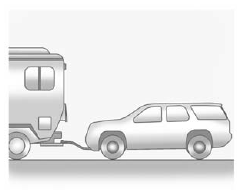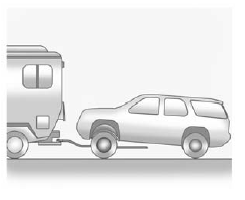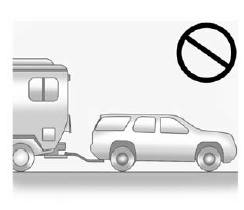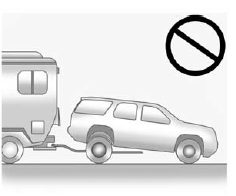Chevrolet Captiva Owners Manual: Towing the Vehicle
Caution
Incorrectly towing a disabled vehicle may cause damage. The damage would not be covered by the vehicle warranty. Do not lash or hook to the chassis components — including the front and rear subframes, suspension control arms, and links — during towing and recovery of a disabled vehicle, or when securing the vehicle. Use the proper nylon strap harnesses around the tires to secure the vehicle.
Have the vehicle towed on a flatbed car carrier. A wheel lift tow truck could damage the vehicle.
Consult your dealer or a professional towing service if the disabled vehicle must be towed.
To tow the vehicle behind another vehicle for recreational purposes, such as behind a motor home, see "Recreational Vehicle Towing" following.
Recreational Vehicle Towing
Recreational vehicle towing means towing the vehicle behind another vehicle, such as behind a motor home. The two most common types of recreational vehicle towing are known as dinghy towing and dolly towing. Dinghy towing is towing the vehicle with all four wheels on the ground. Dolly towing is towing the vehicle with two wheels on the ground and two wheels up on a device known as a dolly.
Here are some important things to consider before recreational vehicle towing:
- What is the towing capacity of the towing vehicle? Be sure to read the tow vehicle manufacturer's recommendations.
- What is the distance that will be traveled? Some vehicles have restrictions on how far and how long they can tow.
- Is the proper towing equipment going to be used? See your dealer or trailering professional for additional advice and equipment recommendations.
- Is the vehicle ready to be towed? Just as preparing the vehicle for a long trip, make sure the vehicle is prepared to be towed.
Dinghy Towing
Front-wheel-drive and all-wheel-drive vehicles may be dinghy towed from the front. These vehicles can also be towed by placing them on a platform trailer with all four wheels off of the ground. For other towing options, see "Dolly Towing" following in this section.
For vehicles being dinghy towed, the vehicle should be run at the beginning of each day and at each RV fuel stop for about five minutes.
This will ensure proper lubrication of transmission components.

To tow the vehicle from the front with all four wheels on the ground:
- Position the vehicle that will be towed and secure it to the towing vehicle.
- Turn the ignition key to ACC/ ACCESSORY.
- Shift the transmission to N (Neutral).
- Turn fog lamps and all accessories off.
- To prevent the battery from draining while the vehicle is being towed, remove the 2 amp PWR/MODING fuse from the instrument panel fuse block and store it in a safe location. See Instrument Panel Fuse Block on page 10-34.
Caution
If the vehicle is towed without performing each of the steps listed under "Dinghy Towing," the automatic transmission could be damaged. Be sure to follow all steps of the dinghy towing procedure prior to and after towing the vehicle.
Caution
If 105 km/h (65 mph) is exceeded while towing the vehicle, it could be damaged. Never exceed 105 km/h (65 mph) while towing the vehicle.
Once the destination has been reached:
- Set the parking brake.
- Shift the transmission to P (Park).
- Reinstall the 2 amp PWR/ MODING fuse to the instrument panel fuse block.
- Turn the ignition key to LOCK/ OFF and remove the key from the ignition.
Caution
Do not tow a vehicle with the front drive wheels on the ground if one of the front tires is a compact spare tire. Towing with two different tire sizes on the front of the vehicle can cause severe damage to the transmission.
Dolly Towing (All-Wheel-Drive Vehicles)
All-wheel-drive vehicles should not be towed with two wheels on the ground. To properly tow these vehicles, they should be placed on a platform trailer with all four wheels off of the ground or dinghy towed from the front. See "Dinghy Towing" earlier in this section.
Dolly Towing (Front-Wheel-Drive Vehicles)

To tow the vehicle from the front with the rear wheels on the ground:
- Put the front wheels on a dolly.
- Move the shift lever to P (Park).
- Set the parking brake.
- Clamp the steering wheel in a straight-ahead position with a clamping device designed for towing.
- Remove the key from the ignition.
- Secure the vehicle to the dolly.
- Release the parking brake.
Towing the Vehicle from the Rear


Caution
Towing the vehicle from the rear could damage it. Also, repairs would not be covered by the vehicle warranty. Never have the vehicle towed from the rear.
Towing a Chevrolet Captiva is a procedure that requires careful attention to safety guidelines outlined in the owner's manual or towing guide. Before attempting to tow the vehicle, it's crucial to understand the towing capacity of the Captiva and ensure that the towing method and equipment used comply with these specifications.
Start by consulting the owner's manual or towing guide to determine the maximum towing capacity of your specific Chevrolet Captiva model. This information will help you select an appropriate towing vehicle or trailer with a towing capacity that matches or exceeds the Captiva's rating.
Choose the correct towing equipment, such as a compatible tow hitch, tow bar, safety chains, and trailer lights. Ensure that all towing equipment is in good condition and properly installed according to manufacturer instructions.
Before towing, conduct a thorough inspection of the Captiva to ensure it is in a towable condition. Check the tires, brakes, suspension, steering, and other critical components for any signs of damage or wear that may affect towing safety.
When attaching the Captiva to the towing vehicle or trailer, follow the manufacturer's guidelines for proper attachment points and securement. Use safety chains or cables to connect the vehicles and ensure they are crossed under the trailer tongue to prevent the tongue from dropping to the ground if it becomes disconnected.
Activate the trailer lights and check that they are functioning correctly before starting to tow. Properly functioning lights are essential for signaling your intentions and maintaining visibility to other drivers on the road.
While towing, drive cautiously and adhere to recommended speed limits and towing guidelines. Avoid sudden acceleration, braking, or sharp turns that may cause instability or loss of control. Use mirrors and signals to communicate with other drivers and maintain awareness of your surroundings.
If towing for an extended period, make periodic stops to check the towing equipment, Captiva, and trailer for any signs of wear or issues. Ensure that the trailer is loaded evenly and that the weight distribution is within safe limits to prevent trailer sway or instability.
After completing the towing operation, conduct a post-towing inspection of the Captiva to check for any damage or issues that may have occurred during towing. Address any concerns promptly to maintain the vehicle's safety and integrity.
By following these guidelines and referring to the owner's manual or towing guide, towing a Chevrolet Captiva can be done safely and effectively, ensuring both the vehicle's and occupants' safety on the road.
 Jump Starting
Jump Starting
For more information about the
vehicle battery, see Battery on
page 10-23.
If the vehicle battery has run down,
you may want to use another
vehicle and some jumper cables to
start your vehicle ...
More about:
Chevrolet Captiva Owners Manual > Warning Lights, Gauges, and Indicators: Safety Belt Reminders, Airbag Readiness Light
Safety Belt Reminders
Driver Safety Belt Reminder
Light
There is a driver safety belt
reminder light on the instrument
cluster.
When the vehicle is
started this light
flashes and a chime may come on
to remind the driver to fasten their
safety belt. Then the light stays on
solid until ...
Chevrolet Captiva Owners Manual
- Introduction
- In Brief
- Keys, Doors, and Windows
- Seats and Restraints
- Storage
- Instruments and Controls
- Lighting
- Infotainment System
- Climate Controls
- Driving and Operating
- Vehicle Care
- Service and Maintenance
- Technical Data
- OnStar
